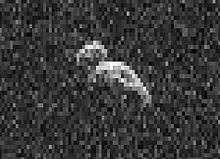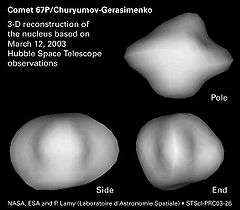2012 VP113
|
Discovery images taken on November 5, 2012. A merger of three discovery images, the red, green and blue dots on the image represent 2012 VP113's location on each of the images, taken two hours apart from each other. | |
| Discovery[1] | |
|---|---|
| Discovered by |
Scott Sheppard Chad Trujillo Cerro Tololo Inter-American Observatory (807) |
| Discovery date |
5 November 2012 announced: 26 March 2014 |
| Designations | |
| MPC designation | 2012 VP113 |
| TNO, sednoid | |
| Orbital characteristics[2] | |
| Epoch 13 January 2016 (JD 2457400.5) | |
| Uncertainty parameter 5 | |
| Observation arc | 739 days (2.02 yr) |
| Aphelion | 438.11 AU (65.540 Tm) (Q) |
| Perihelion | 80.486 AU (12.0405 Tm) (q) |
| 259.30 AU (38.791 Tm) (a) | |
| Eccentricity | 0.68960 (e) |
|
4175.54 yr (1525115 d) 4300 yr (barycentric)[3] | |
| 3.2115° (M) | |
| 0° 0m 0.85s /day (n) | |
| Inclination | 24.047° (i) |
| 90.818° (Ω) | |
| 293.72° (ω) | |
| Earth MOID | 79.5621 AU (11.90232 Tm) |
| Jupiter MOID | 75.862 AU (11.3488 Tm) |
| Physical characteristics | |
| Dimensions |
300–1000 km[4] 450 km (assumed)[4][5] 600 km[6] |
|
0.15 (Nature; 2014)[5] 0.1 (Brown website)[6] | |
|
(moderately red) V−R = 0.52 ± 0.04[5] B−V = 0.92 | |
| 23.4 | |
|
4.0 (MPC)[7] 4.0 (JPL)[2] 4.3[6] | |
|
| |
2012 VP113 is a planetoid in the outer reaches of the Solar System. It is the object with the farthest known perihelion (closest approach to the Sun) in the Solar System, farther than Sedna's.[8] Its discovery was announced on 26 March 2014.[5][9] It has an absolute magnitude (H) of 4.0,[7] which makes it likely to be a dwarf planet,[6] and it is accepted as a dwarf planet by some.[10] It is expected to be about half the size of Sedna and similar in size to Huya.[4] The similarity of 2012 VP113's orbit to the orbits of other known extreme trans-Neptunian objects led Scott Sheppard and Chad Trujillo to suggest that an undiscovered super-Earth in the outer Solar System is shepherding these distant objects into similar type orbits.[5]
Its surface is thought to have a pink tinge, resulting from chemical changes produced by the effect of radiation on frozen water, methane, and carbon dioxide.[11] This optical color is consistent with formation in the gas-giant region and not the classical Kuiper belt, which is dominated by ultra-red colored objects.[5]
History
Discovery
2012 VP113 was first observed on 5 November 2012[1] with NOAO's 4-meter Víctor M. Blanco Telescope at the Cerro Tololo Inter-American Observatory.[12] Carnegie’s 6.5-meter Magellan telescope at Las Campanas Observatory in Chile was used to determine its orbit and surface properties.[12] Before being announced to the public, it was only tracked by Cerro Tololo Inter-American Observatory (807) and Las Campanas Observatory (304).[7] It has an observation arc of about 2 years.[2] Two precovery measurements from 22 October 2011 have been reported.[7] A primary issue with observing it and finding precovery observations of it is that at an apparent magnitude of 23, it is too faint for most telescopes to easily observe.
Nickname
2012 VP113 was abbreviated "VP" and nicknamed "Biden" by the discovery team, after Joe Biden, the Vice President (VP) of the United States.[9]
Orbit
2012 VP113 has the largest perihelion distance of any known object in the Solar System.[13] Its last perihelion was around 1979,[lower-alpha 1] at a distance of 80 AU;[2] it is currently 83 AU from the Sun. Only eight other Solar System objects are known to have perihelia larger than 47 AU: Sedna (76 AU), 2014 FZ71 (56 AU), 2015 FJ345 (52 AU), 2014 FC72 (52 AU), 2004 XR190 (51 AU), 2010 GB174 (48 AU), 2014 SR349 (48 AU) and 2004 VN112 (47 AU).[13] The paucity of bodies with perihelia at 50–75 AU appears not to be an observational artifact.[5]
It is possibly a member of a hypothesized Hills cloud.[4][12][14] It has a perihelion, argument of perihelion, and current position in the sky similar to those of Sedna.[4] In fact, all known Solar System bodies with semi-major axes over 150 AU and perihelia greater than Neptune's have arguments of perihelion clustered near 340 ± 55°.[5] This could indicate a similar formation mechanism for these bodies.[5] (148209) 2000 CR105 was the first such object discovered.
It is currently unknown how 2012 VP113 acquired a perihelion distance beyond the Kuiper belt. The characteristics of its orbit, like those of Sedna's, have been explained as possibly created by a passing star or a trans-Neptunian planet of several Earth masses hundreds of astronomical units from the Sun.[15] The orbital architecture of the trans-Plutonian region may signal the presence of more than one planet.[16][17] 2012 VP113 could even be captured from another planetary system.[10] However, it is considered more likely that the perihelion of 2012 VP113 was raised by multiple interactions within the crowded confines of the open star cluster in which the Sun formed.[4]
| Object name | Distance from the Sun (AU) | Apparent magnitude |
Absolute magnitude (H) | |||||||||||||||||||||||||||||||||||||||||||||||||||||||||||||||||||||||||||||||||||||||||||||||
|---|---|---|---|---|---|---|---|---|---|---|---|---|---|---|---|---|---|---|---|---|---|---|---|---|---|---|---|---|---|---|---|---|---|---|---|---|---|---|---|---|---|---|---|---|---|---|---|---|---|---|---|---|---|---|---|---|---|---|---|---|---|---|---|---|---|---|---|---|---|---|---|---|---|---|---|---|---|---|---|---|---|---|---|---|---|---|---|---|---|---|---|---|---|---|---|---|---|---|
| Current | Perihelion | Aphelion | ||||||||||||||||||||||||||||||||||||||||||||||||||||||||||||||||||||||||||||||||||||||||||||||||
| V774104 | 103 | N/A | N/A | 24 | 4 | |||||||||||||||||||||||||||||||||||||||||||||||||||||||||||||||||||||||||||||||||||||||||||||
| Eris | 96.2 | 37.8 | 97.6 | 18.7 | -1.2 | |||||||||||||||||||||||||||||||||||||||||||||||||||||||||||||||||||||||||||||||||||||||||||||
| 2014 UZ224 | 91.6 | 38.0 | 179.8 | 23.2 | 3.5 | |||||||||||||||||||||||||||||||||||||||||||||||||||||||||||||||||||||||||||||||||||||||||||||
| 2007 OR10 | 87.6 | 33.0 | 100.8 | 21.7 | 2.5 | |||||||||||||||||||||||||||||||||||||||||||||||||||||||||||||||||||||||||||||||||||||||||||||
| 2013 FS28 | 86.2 | 34.6 | 347.6 | 24.5 | 4.9 | |||||||||||||||||||||||||||||||||||||||||||||||||||||||||||||||||||||||||||||||||||||||||||||
| Sedna | 85.6 | 76.0 | 939 | 21.0 | 1.6 | |||||||||||||||||||||||||||||||||||||||||||||||||||||||||||||||||||||||||||||||||||||||||||||
| 2014 FC69 | 84.4 | 40.3 | 106.9 | 24.1 | 4.6 | |||||||||||||||||||||||||||||||||||||||||||||||||||||||||||||||||||||||||||||||||||||||||||||
| 2006 QH181 | 83.6 | 37.8 | 96.7 | 23.6 | 4.3 | |||||||||||||||||||||||||||||||||||||||||||||||||||||||||||||||||||||||||||||||||||||||||||||
| 2012 VP113 | 83.3 | 80.5 | 438 | 23.4 | 4.0 | |||||||||||||||||||||||||||||||||||||||||||||||||||||||||||||||||||||||||||||||||||||||||||||
| 2013 FY27 | 80.2 | 36.1 | 81.8 | 22.1 | 3.0 | |||||||||||||||||||||||||||||||||||||||||||||||||||||||||||||||||||||||||||||||||||||||||||||
| 2014 FJ72 | 71.1 | 38.7 | 152.2 | 24.2 | 5.6 | |||||||||||||||||||||||||||||||||||||||||||||||||||||||||||||||||||||||||||||||||||||||||||||
| 2010 GB174 | 71.1 | 48.7 | 693 | 25.1 | 6.5 | |||||||||||||||||||||||||||||||||||||||||||||||||||||||||||||||||||||||||||||||||||||||||||||
| 2012 FH84 | 68.6 | 45.8 | 80.6 | 25.7 | 7.3 | |||||||||||||||||||||||||||||||||||||||||||||||||||||||||||||||||||||||||||||||||||||||||||||
| 2011 GM89 | 68.3 | 37.2 | 68.8 | 25.6 | 7.1 | |||||||||||||||||||||||||||||||||||||||||||||||||||||||||||||||||||||||||||||||||||||||||||||
| 2015 GR50 | 68.2 | 35.6 | 78.6 | 25.1 | 6.7 | |||||||||||||||||||||||||||||||||||||||||||||||||||||||||||||||||||||||||||||||||||||||||||||
| 2015 GP50 | 68.1 | 35.9 | 89.1 | 24.8 | 6.5 | |||||||||||||||||||||||||||||||||||||||||||||||||||||||||||||||||||||||||||||||||||||||||||||
| 2013 FQ28 | 67.5 | 48.7 | 80.6 | 24.4 | 6.0 | |||||||||||||||||||||||||||||||||||||||||||||||||||||||||||||||||||||||||||||||||||||||||||||
| 2013 UJ15 | 64.4 | 36.3 | 69.2 | 25.2 | 7.0 | |||||||||||||||||||||||||||||||||||||||||||||||||||||||||||||||||||||||||||||||||||||||||||||
| 2015 RR245 | 63.9 | 33.7 | 129.2 | 22.1 | 3.9 | |||||||||||||||||||||||||||||||||||||||||||||||||||||||||||||||||||||||||||||||||||||||||||||
| 2014 SG350 | 63.0 | 39.9 | 63.9 | 24.8 | 6.8 | |||||||||||||||||||||||||||||||||||||||||||||||||||||||||||||||||||||||||||||||||||||||||||||
| 2014 FL72 | 62.1 | 38.2 | 170.4 | 25.0 | 6.8 | |||||||||||||||||||||||||||||||||||||||||||||||||||||||||||||||||||||||||||||||||||||||||||||
| 2013 AT183 | 62.1 | 36.0 | 88.1 | 22.0 | 4.7 | |||||||||||||||||||||||||||||||||||||||||||||||||||||||||||||||||||||||||||||||||||||||||||||
| 2014 FE72 | 61.8 | 36.3 | 4274.0 | 24.1 | 6.1 | |||||||||||||||||||||||||||||||||||||||||||||||||||||||||||||||||||||||||||||||||||||||||||||
| 2014 SV349 | 61.3 | 34.2 | 89.0 | 23.0 | 5.0 | |||||||||||||||||||||||||||||||||||||||||||||||||||||||||||||||||||||||||||||||||||||||||||||
| 2000 CR105 | 60.8 | 44.3 | 412 | 23.9 | 6.3 | |||||||||||||||||||||||||||||||||||||||||||||||||||||||||||||||||||||||||||||||||||||||||||||
| 2014 SU349 | 60.7 | 30.8 | 109.8 | 25.0 | 7.0 | |||||||||||||||||||||||||||||||||||||||||||||||||||||||||||||||||||||||||||||||||||||||||||||
| 2014 FF72 | 60.7 | 37.1 | 63.3 | 24.8 | 6.9 | |||||||||||||||||||||||||||||||||||||||||||||||||||||||||||||||||||||||||||||||||||||||||||||
| 2014 FM72 | 60.4 | 34.4 | 76.6 | 24.1 | 6.2 | |||||||||||||||||||||||||||||||||||||||||||||||||||||||||||||||||||||||||||||||||||||||||||||
| 2014 FH72 | 60.1 | 37.3 | 77.3 | 25.1 | 7.2 | |||||||||||||||||||||||||||||||||||||||||||||||||||||||||||||||||||||||||||||||||||||||||||||
| 2008 ST291 | 60.1 | 42.4 | 154.5 | 22.2 | 4.2 | |||||||||||||||||||||||||||||||||||||||||||||||||||||||||||||||||||||||||||||||||||||||||||||
| 2003 QX113 | 60.0 | 36.7 | 62.1 | 22.5 | 4.7 | |||||||||||||||||||||||||||||||||||||||||||||||||||||||||||||||||||||||||||||||||||||||||||||
| 2015 KH162 | 59.2 | 41.5 | 82.8 | 21.6 | 3.9 | |||||||||||||||||||||||||||||||||||||||||||||||||||||||||||||||||||||||||||||||||||||||||||||
| Including all known objects currently located at least twice as far as Neptune.[18] See List of trans-Neptunian objects for more. | ||||||||||||||||||||||||||||||||||||||||||||||||||||||||||||||||||||||||||||||||||||||||||||||||||
Comparison

See also
- List of Solar System objects most distant from the Sun in 2015
- V774104
- 90377 Sedna (relatively large and also distant body)
- List of hyperbolic comets
- Pluto
- Have very large aphelion
Notes
- ↑ The 1-sigma uncertainty in the year of perihelion passage is ~4 years using JPL solution 2.[2]
References
- 1 2 "MPEC 2014-F40 : 2012 VP113". IAU Minor Planet Center. 2014-03-26. Retrieved 2014-03-26. (K12VB3P)
- 1 2 3 4 5 "JPL Small-Body Database Browser: (2012 VP113)" (last observation: 2013-10-30 (arc=~2 year)). Jet Propulsion Laboratory. Retrieved 3 April 2016.
- ↑ Horizons output. "Barycentric Osculating Orbital Elements for 2012 VP113". Retrieved 2016-01-23. (Ephemeris Type:Elements and Center:@0)
- 1 2 3 4 5 6 Lakdawalla, Emily (2014-03-26). "A second Sedna! What does it mean?". Planetary Society blogs. The Planetary Society. Retrieved 2014-03-27.
- 1 2 3 4 5 6 7 8 9 Trujillo, C. A.; Sheppard, S. S. (2014). "A Sedna-like body with a perihelion of 80 astronomical units" (PDF). Nature. 507 (7493): 471–474. Bibcode:2014Natur.507..471T. doi:10.1038/nature13156. Archived (PDF) from the original on 2014-12-16.
- 1 2 3 4 Brown, Michael E. (2014-04-17). "How many dwarf planets are there in the outer solar system? (updates daily)". California Institute of Technology. Retrieved 2014-04-17.
- 1 2 3 4 "2012 VP113 Orbit" (arc=739 days over 3 oppositions). IAU Minor Planet Center. Retrieved 2014-03-26.
- ↑ Chang, Kenneth (2014-03-26). "A New Planetoid Reported in Far Reaches of Solar System". New York Times. Retrieved 2014-03-26.
- 1 2 Witze, Alexandra (2014-03-26). "Dwarf planet stretches Solar System's edge". Nature. doi:10.1038/nature.2014.14921.
- 1 2 Sheppard, Scott S. "Beyond the Edge of the Solar System: The Inner Oort Cloud Population". Department of Terrestrial Magnetism, Carnegie Institution for Science. Retrieved 2014-03-27.
- ↑ Sample, Ian (2014-03-26). "Dwarf planet discovery hints at a hidden Super Earth in solar system". The Guardian. Retrieved 2014-03-27.
- 1 2 3 "NASA Supported Research Helps Redefine Solar System's Edge". NASA. 2014-03-26. Retrieved 2014-03-26.
- 1 2 "JPL Small-Body Database Search Engine: q > 47 (AU)". JPL Solar System Dynamics. Retrieved 2014-03-26.
- ↑ Wall, Mike (2014-03-26). "New Dwarf Planet Found at Solar System's Edge, Hints at Possible Faraway 'Planet X'". Space.com web site. TechMediaNetwork. Retrieved 2014-03-27.
- ↑ "A new object at the edge of our Solar System discovered". Physorg.com. 2014-03-26.
- ↑ de la Fuente Marcos, Carlos; de la Fuente Marcos, Raúl (1 September 2014). "Extreme trans-Neptunian objects and the Kozai mechanism: signalling the presence of trans-Plutonian planets". Monthly Notices of the Royal Astronomical Society: Letters. 443 (1): L59–L63. arXiv:1406.0715
 . Bibcode:2014MNRAS.443L..59D. doi:10.1093/mnrasl/slu084.
. Bibcode:2014MNRAS.443L..59D. doi:10.1093/mnrasl/slu084. - ↑ de la Fuente Marcos, Carlos; de la Fuente Marcos, Raúl; Aarseth, S. J. (11 January 2015). "Flipping minor bodies: what comet 96P/Machholz 1 can tell us about the orbital evolution of extreme trans-Neptunian objects and the production of near-Earth objects on retrograde orbits". Monthly Notices of the Royal Astronomical Society. 446 (2): 1867–1873. arXiv:1410.6307
 . Bibcode:2015MNRAS.446.1867D. doi:10.1093/mnras/stu2230.
. Bibcode:2015MNRAS.446.1867D. doi:10.1093/mnras/stu2230. - 1 2 "AstDyS-2, Asteroids - Dynamic Site". 2016-02-26. Retrieved 2016-02-29.
Objects with distance from Sun over 59 AU
External links
![]() Media related to 2012 VP113 at Wikimedia Commons
Media related to 2012 VP113 at Wikimedia Commons
- Orbital simulation from JPL (Java) / Horizons Ephemeris
- 2012 VP113 Inner Oort Cloud Object Discovery Images from Scott S. Sheppard/Carnegie Institution for Science.
- 2012 VP113 has Q=460 ± 30 (mpml: CFHT 2011-Oct-22 precovery)
- 2012 VP113 at the JPL Small-Body Database


_(cropped).jpg)



